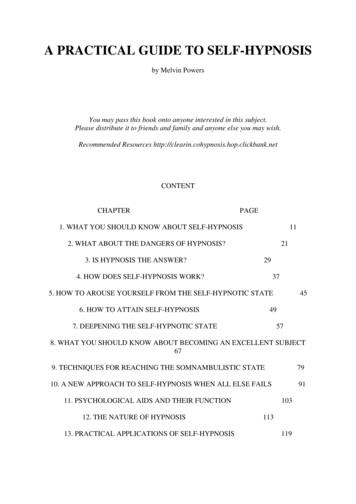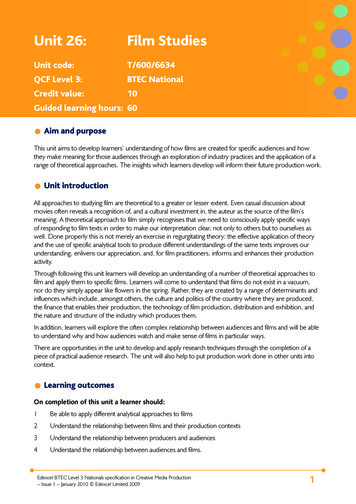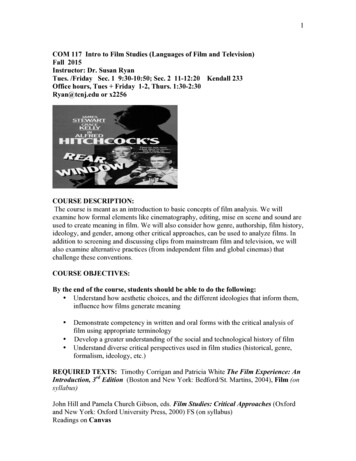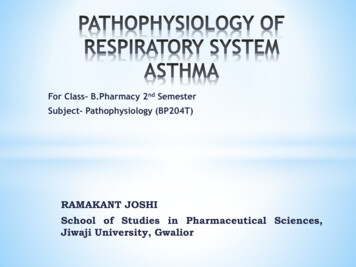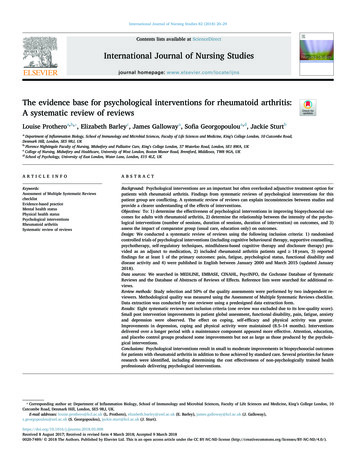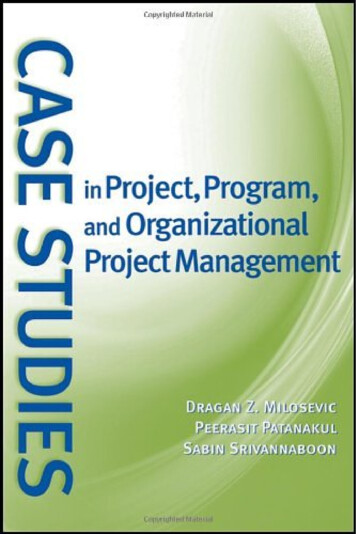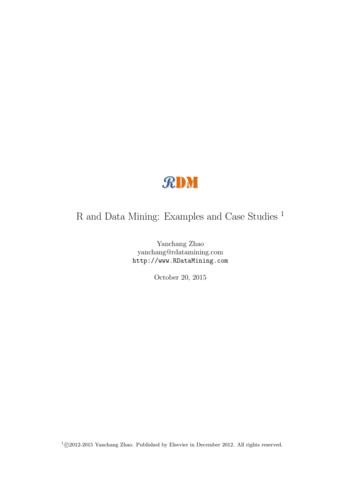
Transcription
LIBRARY OFNEWELL DAYLEYHWYVKI.ilimilllgMM-* *t\r.iwwraJMMlEMMXPractical studiesfor theCORNET(andTRUMPET) 0S JBY'GOLDMANEDWIN FRANKO 1.50Price V ST V 243Carl FischerINC.62 Cooper Square, New York 3BOSTON CHICAGO DAUAS ocFR 4-2318
f sBrigham Young UniversityHarold B. Lee LibraryGift ofK.INewell Dayley
/v&u/e,// uDc? y/tVy-60LIBRARY OFNEWELL DAYLEYPRACTICAL STUDIESfor theCORNETijg(andTRUMPET)gbyEDWIN FRANKOGOLDMANIPCARL FISCHERS8S51SNEW YORK-
Copyright 1921 by Carl Fischer,NewYorkInternational Copyright SecuredPrinted in U.S.A.HAROLDB.LEE LIBRARY9RIGHAM XOUNG UNIVERSITYPROVO UTAH
Practical StudiesEach one of thesestudies has been written for thepurpose of developing some-They have been called "Practical Studies because theyrepresent the various forms and styles that the average musician is apt to be confronted with at any time. If properly and carefully practised, these studies shouldperfect the tong-uing", whether it be in single, double or triple form. They will alsocertain phase of playing-.improve the tonal quality, technic, phrasing and rhythm, andvast amount of surety and endurance.-,g*ive to the player aThe performer who can render these studies as they should be played, will beable to do justice to any piece of music that may be set before him in either orchestra or band. He will at the same time be able to perform any of the standardcornet solosItisinanartisticmanner.not necessary that these studies be practised'in the orderprinted.The student may choose anyinwhich they areexercise at random.EDWIN FRANKO GOLDMANJune, 19202ZQ%Z-11
1.Staccato Tonguing*This staccato study should be practised slowly at first, and also with very even tong-uing*. After it hasbeen mastered in slow tempo, begin to play it faster. In fact, it should be played as quickly as possible without sacrificing* smoothness or clarity.rail.a tempocc22042-41MCMXXIby Carl Fischer, NewInternational Copyright SecuredCopyrightYork
2.Alternate Tong-uing- and SlurringThis study should be played with great care. Slur only the notes marked. All the sixteenths and eighthsmust be played as staccato and evenly as possible. In order to make the music sound ligrht and brilliantalso play the second note of each slurred group of two, very short. It is essential to accent the notes that,are so marked. Play slowly atfirst. *I4 JJ Jj J22043-41N1W"T-/
4Staccato3.Tonguing-In exercises of this kind, the student must be extremely careful tothe intervals are rather difficult.have the intonation accurate. Some ofTherefore do not attempt to play with speed at first. Precise sharp,tonguing* is essential.ModeratorffJCr Qj]' r L f Qjjj 6ccrcc*fcfc 22042-41fii
,LIBRARY OFAEWELL DAYLEY4.Staccato Tong-uing-This study should in reality be counted in 4/8 time, with a triplet on each eighth count. If practised properly it will help to give one a certain degree of ligiitness and delicacy of tong-uing-, and at the same timeaccuracy and speed.33111 tilt[220*2U
5.Staccato Tong-uing*This is another study that will help to improve the tong-uing*. Be careful to play all eighth and sixteenth notesvery staccato, and try to maintain the same quality of tone throughout. brilliant style is required for music ofthis kind.Af\moderatoAllegro piL.LL1.LCE3 1fp INa tempo4y?o-i?-4ik\tM l mhe \*»J)7V
6.Dotted NotesThis particular rhythm seems to bother most players. All the dotted notes come directly on the beat, andthey should not sound too long* or too short. The sixteenths must be played lightly, quickly, and staccato. Thestudy looks very simple, but requires careful practise.*in ff wzdtpiU\rmmm# tempo 220*2-11**frail.mff
87.sameDotted Notesperhaps somewhat moredotted eighth notes are g'iven equal value. The sixteenths must also be even.Whilein the#istyle as the previous exercise, thism m'04ma »/m &Ia TTcjCJICJ-mte iipi»? fi§cjPHiwi3 Smfmuur/d S-J W Ncr alltra HLLlCMj-j riFgicl 25i(m-*f&m' m mSee that s* msIfrnrjhjMu- *difficult. & m/ Pmis *-J tdH-Ir r jirs rrTrl 9 m
98.SharpTrumpet StyleEvery eig-hthand sixteenth note must be staccato. Play slowly at first. Eventually count one in a bar. Always bear in mind that quick tong uing- must be light tong-uing-.Much music for the Trumpet is written in this style. It should be played with snap and brilliancy.tong-uing- is the feature of this study.,*pff#320 42 1mil/
109.Trumpet StyleNo trumpet player canpossibly achieve success unless he can tong*ue with precision and speed.Realtrumpet parts call for staccato tonguing*, to a great extent. In an exercise of this kind the eighths as wellas the sixteenths must be played as short as possible, and the rests must be observed. Brilliancy is a requisite.m m m. mm mra* mtUaJL-yipES/*nmLMmm?*-innsi'rijr rffirrishfr, 6jgfr ryriCrrccTitm22042-41
11Intervals10.The slowerthis exercisepractised at the start, the greater the benefit will be. Each note should beplayed as distinctly as though it stood alone. In going- from a nig-h note to a low one, or from a low noteto a hig-h one, there must be no difference in either quantity or quality of the tone. The proper practice ofthis will give to the player great surety and accuracy of attack. Be careful of the intonationis.Not too fast PWPI4 %r?n 5/-a, mwIPpfli0 f -pDy r »yJ11i mi :-: U 2v vmnmLT U-'cJiBTErjrgi#.praniipkj 5Jl ]'.23013-4ia- »f&Am Jm #gn# SL*. ff# «l«Pnm nmb PSfeg --fli1 1m *lwteS5T m
1211.IntervalsAccurate intonation and even quality of tone are the important factorsIt is on the same order as the preceding: study.Very slowlym4an exercise of this kindat firstm. fc SEmm#of15m m*&fct mt*s4 41 E&s#iE mte&i§iplcfcfe#J r st m* 3ttEE*s m* r tMJJm&SC22043-\\ITy !y
P1312.Much musicthat theaverageSyncopationcornetist is confronted with,written in syncopation, particularly theso-called popular and rag-time numbers. The present study has the form of a "fox- trot" which is one ofthe popular dances of the day. Count two in a bar. Play all the eighths staccato, and give the quarters fullvalue. This will make the syncopation stand out boldly. Accent most of the quarter notes very slightly as marked atisthe beginning*.ModeratoiNI- **bZ5rrirj r JUip irfj J22042 41uijjJ" jr*IP r mj jJ?r gp lyrNr J)Jprrr jr rhp r rpJJrcjr rj'Tprp jJ3JJ ' Jm!rp/ rjpr-'UJipffc pm p i ita-vi P irpJjjpiPPrpirpiy r
ii13.SyncopationPassages such as contained in this study are met with in most popular and ragtime numbers, and evenin a considerable amount of standard music. The syncopated or longer notes should be accented slight ly to help bring* out the syncopated rhythm. In music of this kind the eighth notes should be long* andthe sixteenths very short. Where two sixteenths are joined, they have the value of an eighth.,ModeratoPmgaw "/Z #fe z zzn mI1g# /pn l - /f .i .prKEri— w/# ig w P4J0-0*:220*3-41 S
1514.The explanationSyncopationof the previous exercise willapply similarly tothis study.Moderator r guppllmm§*4Si»-2?fTM a*smm m'l22042-41Ererttir fCtrrffr ttffflaiiijffHts*
1615. Leg-atoTo rendersmoothness of style is necessary. Sustain the notes well, and give eachits proper value. Be careful not to hurry the triplets. Some of the slurs are rather difficult.If thisexercise is mastered, the performer should have no difficulty in rendering* song's and arias in proper style.this study properly,Moderatorail.mmmmm22042-41-95-
16.BeSlurring"careful not to shorten the. last note of each triplet.note of each bar, but do not accentnThatisa commonfault.Only tong-ue thefirstit.Moderato#m -0XEmfpHi B wmm"JJ ? '[[r:1 'ivmitimmmmiiTjrfLTr mmfrfr W fr 1 0m32043413
is17.The same advice giv entwo previousfor theSlurring-studies will apply here.Smoothnessisvery important in thisexercise.AllegrettoSP3mf3S§1 3msffi*T*-»- -»SSfpPIim 7m ;zfc *8 iipbr ffi jflcrT'Ir i CJ JDijjZijjj jjj rrt:*tiluffsjorSI»-rN j J 4ijpjr':i CCT TS§ha tempot g'f**" [Tfeii i rail. r jnirprffC?}fr J Tri220*2-41!*-9OTfffqcW r Jj.iiJWf i
—V)18. TrillThis slow movement is intended to develop the playing- of trills. A trill is supposed to be purely ornamental,and should therefore be rendered in a graceful manner. Do not move the entire hand when trilling-, but useonly the fing'er. Some of these trills are easy, while others are difficult and require careful practice.AndantetrE3Q6 -IS»i-/mfpfftrPE4If5H JfJIastr *JIJ/If**little faster2 itswtrC\ppsS—7*w g& 2Htr* tr- mff-fj jpf r ee *'mJ frail.Cadenza ad tr #*'Pm/Lm-Od}*lib.trNkaJJJ.-— tr T A;-G-*-?#gl J12-i-- rJ JJw 4 J1 Hl-J1—— — — -W— 3--rail.a tempotrtrP &m "r ijir\1Strmmfmm22042-41trtres fc 3ftE *
20Cadenzas19.Most instrumental solos in the larger forms contain one or two cadenzas. When a cadenza is found, itindicates that the measure of time is to be suspended, and its performance left to the judgment and taste cftha player. Cadenzas should be played in a free (ad libitum) style so as to display the tone, technic andother qualities of the player to the best possible advantage. As cadenzas are unaccompanied, they mustbe played with extreme care. Let every note sound, and do not sacrifice precision and style for speed.i g m yT V thr/T\jgg'& r\?r\ 3 SzitiUfuz: lOTTn*-#4/C\ '"J-U mmmSgBSm mzm23iBSCSSES CS S3 3 CSC S SC9E946ff# jjjj*-* ' ' iijokCT JflJjg22042 41-mjgMggis«sg -- jy
—j21ggfcjSjgg 3i8 jej*4Sv /?\*n1'm» ? z: *Is#y j'n-fcfapjr* «;.«mE /T\ §isRH* ?- * J «r\rrr? ffee '/rsIiPP#[? 2204211r OJ *tMr 97sP0\/T\/C\/T\9i tb*7—B3«JJJJJJJJge fe4- :-*Pii »MEE35
2220. Grace Notes(Single)Grace notes are ornaments, and as their name implies must be played in a graceful manner. Lightness and delicacy are the principal requirements of these notes. Do not accent them. Just touch themlightly and slur into the following: note. Only single grace notes are used in this study.Grazioso*;ucririmf4* *ItW-nm ua-fiBF*TS p.- 8 * .FTTeg ji j]j]i. riJ". Si# tempo P rail. -ifep y rmra//. / z tempo'rp"gp/* *w. 22042-41 - XJf'-
*.j- LIBRARY OFNEWELL DAYLEYGrace Notes21.*3(Double)In this study, two grace notes are introduced. They should be played in a delicate manner, but bothshould be distinctly heard. The two grace notes should be slurred to the following- eig-hthnote, makingthree slurred notes in all. Lightness should characterize this entire study.Allegroj moi m mWfltrft MEE JTJ * In 53?\m3 m—* J * p j —m—9dIfJl j JT?i fii7?iJ JjjuJli i3Ei/J'JESfgr 5 J?l Jjj js»3#im s? *nt** S §0—-0m0- -0m 3g TTJg * JTflf 5m biwnjJ w/" dolce4**0-0SI- —#220*2 —r P— f !!Hi. - F"7 . ) lJT3 j-j]fljjiTJJ I.- 11. IlEfc» m— I p p v I*ypgJTjiJJJuJjJ XW M—W—W—L jjIgfts2S55*3 j/PILLT fefg P LU grTT T 71»JjfijjP5 5 8 0.-00'P F #ssfcft - 4m0-0 ftaa pjnuifflSI
2422. Grace NotesThe explanatory notes in connection with the two preceding- studies also applyrespect. They should all be practised with great care and attention as to detail.&Allegretto— — U.p\w r *» -W *-m everyi&gse -rz:/K-TTmi .'. to this one inJr f„il\1 \Kre f1 1H2 mP ?. *:t#*i//a )fP-t— *- jrrfei mW rrrrl ji ir-au-mr/C\tse/-«//aa tempo PP m4*rteE*'jti i —#32042-41ifV 1fLd"iLC&-IBS311 IJT. y is*Jt *S !.I
—*»23. Tripletsa study ofthis kindnote which notes are slurred, and which are tong-ued. Do not accent the first note of each triplet. Accuracy of fingering- is necessary. Play slowly atfirst, counting- four eighths to the bar.Init isessential, first ofall, to pig cfl-iJaWcflrif&m B3EH»actftggwajJBtfr psp. &* s? fflrtffrJJJifffffl a /{'#/ sloweriijnagffls r ro.i JT SpsS s a ' iti«?--i# #pbe#s*a tempoIB?i frfifriifi«?.Jl r fr v izs\a.eSSeI r J * Cdcr' mjltk yifi& Wm wttfj iffltfrrj'igr f be:* w J]a i33043-41
—»se24. TripletsThis study should be practiced with great care, in order to g-ain accurate rhythm. Observe the marksand count four eighths to the bar at first.AllegrettomZM33#—m T7T j;\Um7?3p' m441 JJ F-.?33 rrg „irW- LM2 W Ww"if& I:P y3 -F-T§njmi m m1iJFm310 ,sm rfT 3 p"P"i'55*«iF F* 3m—z—mx ?AImi«pf11Sm w my*tempo#rail4 am—m 3p §7 ?22042-41 T - mm-»m- -m3i3 :3m Vm—m#-?EfSg-y# F #.me3m w mmfm y3mm5m
2725. For Lightness and SpeedAfter this study has been mastered, the student may play it in the fastest possible tempo. Be carefulto accent the notes marked. Remember that without lightness there can be no speed. PrestopfFljTr fi & 0jff ri» fl »i5 4ifjfTrcPff»»El30 mI Stfr -ir r prS* iv' j jj mis:tfrlTf#-w-#§ iT f f i Ir ljjgp 5 *22042-41H*,Ai p ;Fr Figg«as s ifci&s »t* » ?'M* "i'»/ iI1 THfo'rrr ffrf* i§T \F#Ff» l re1t T»-;r jgsn
3826.Valse EtudeThis"Valse Etude"is a practical study and should be rendered with taste and discretion.Not too'"tfastMrl* r » r#m1w/»49ih-«ii «jVhpff j »- jg -g§ r"rr&SS#th*#pllf.Jif22043-41J 3mf jfm4*Nj *u J'- -P# g9tr.gJwp\\*3 flm%rs .i* * * #»*Iil? k. *HPi J J g i * «?/*J ife?Ir—fl* fHi* * aw *ggg5 jPppes *anra ft fie*,g 5HiSifr/rj cjie iT
27.*9CavatinaIn this "Cavatina" the student is given an opportunity to display g-ood phrasing-, as well as finetonal quality. Do not play the eighth or sixteenth notes short in music of this kind.AndanteBam«/ ';MS# P 1gNdr Frb*i-p# ! a,**-TT1i '«/ fM m'"r r rri1J"*sif 3 P PPFss§ #J 52'21,ftF rliitfj PdJ.«VJ»MXJ*kEy'PJ./C\jrtrTempo# ik Tijtj-3LU,I 3F-mif frjkyjpj/* JJ zz 22043-44-r Vfk 1/iSflfl rTr\ i / mtrail.
j3028. Etude brillanteAnopportunity for brilliant playing-isafforded in this study. Play the music precisely as written.Allegro maestosoi** /# 30—m-Sejfetj ftI 1»pT ,JTfliJJTnilH m m wfdolceimaH fe91 % # Bt pa1 -#tt a %1 F?s atfimm JW'Ufr # tempo32042-41r j0 z**mmn rm nn A-m JvJ.3tWram* Jm i
31Triple Tong'uing*Triple Tong-uing"isa form of staccato whichisused for playing" triplets (singly or ingroups) where the necessary speed cannot be obtained with ordinary orT T K,sing-le tong-uing*.Tu Tu Ku.It isan effect obtained by the pronunciationIt
t. In an exerciseof this kind the eighths as well as the sixteenths must beplayedas short as possible, and the rests must beobserved.

